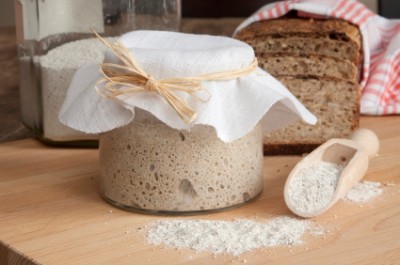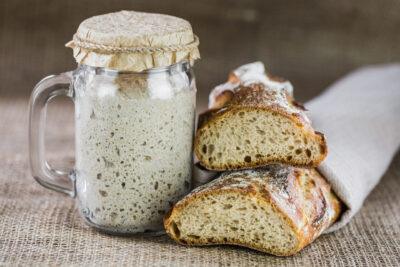Sourdough Starter Made Simple
Sourdough bread is the oldest form of leavened bread in the world, dating back to ancient Egypt. Sourdough uses a lactobacillus and yeast culture rather than cultivated yeasts as a leavening agent. The lactic acid created as a by-product of the lactobacilli gives sourdough bread its distinctive tangy flavor, while the yeast provides the leavening and digests the byproducts of the lactobacilli.
Unlike cultivated yeasts, sourdough “starters” with homegrown lactobacilli are very easy to start and maintain at home. Once begun, sourdough starters can live for years or even for generations. Many bakeries or other restaurants that bake their own bread keep the same sourdough starter for as long as the restaurant remains open to ensure that their bread keeps the same unique flavor. Sourdough starters have even been passed down from grandparents to parents to children as family heirlooms.
How Does It Work?
While it may sound off-putting, the truth is that all sorts of microorganisms naturally live in flour, including the two that are important to a sourdough starter. When a starter is nurtured properly, the yeast and lactobacilli will eventually grow a strong symbiotic colony and kill off any other bacteria in the process. It can take several days for the right bacteria to take hold, and until that time your starter may give off an unpleasant smell and generally resemble something you don’t particularly want to use for cooking.
Your skin also contributes some bacteria to the process. This is one cooking activity for which you do not want the most sterile ingredients and tools possible. Whole grain flours are better since they naturally contain more bacteria, and you do not want to sterilize your flour before you begin or your starter will not go anywhere.
Growing Your Sourdough Starter
There is both a simple way and a more complicated way to grow a sourdough starter, although in truth neither way is immensely difficult. The complicated method mostly involves a great deal of time and patience, and possibly some trial and error.
The first method involves taking a small amount of unbaked sourdough for your base since this dough will already contain live cultures of lactobacilli and yeast. This dough can come from a sourdough that you purchase, or from a starter or dough that you snitch from an acquaintance. With healthy cultures already at home in this dough, all you have to do is keep feeding it.
To start a new culture you will need to make a brand-new dough out of a flour and water base and wait for a culture to begin to form. You should be able to grow a good culture in about a week’s time if you keep your dough under the right conditions.
While there are many different methods of beginning a sourdough starter, I have found that this method detailed on the website Sourdough Home is a great resource. The website also has a couple of other methods that sourdough bakers can try, but the Professor Calvel recipe is a tasty and reliable place to start.
This method takes about two and a half days to grow a sourdough starter, and bakers will need wheat flour, rye flour, salt, water, and dried malt extract. Do not use distilled water for your starter, since the minerals naturally found in water are important for helping your starter to grow. If your tap water smells or tastes funny, use bottled water for your starter.
This particular recipe uses both whole wheat and rye flour, and most starter recipes you will find also opt for rye, wheat, or a combination rather than white flour. However, you do not need to use the same type of flour to bake your bread as you used for your starter; for example, you can make a white sourdough loaf using a starter fed with rye.
Starters need time to grow and to eliminate unwanted bacteria, so you should only bake with starters that are at least one week old – preferably older. Starters should also be healthy, as demonstrated by their ability to more or less double in size each time you feed them.

Sourdough bread is the oldest form of leavened bread in the world.
Maintaining Your Sourdough Starter
Keeping a sourdough starter is not unlike keeping a very low maintenance pet. In fact, your lactobacilli culture is alive and needs some of the same care that you would give to a more traditional pet. It may seem bizarre to carefully cultivate a strain of bacteria when we work so hard to eradicate bacteria in most areas of our homes, but these little cultures are special. Keep them healthy and happy, and you will have the key to great bread for as long as you choose!
Your sourdough starter needs food and water and must be kept at an appropriate temperature. There are a couple of options for your starter during the first few months: it can be kept in a relatively warm place and fed twice a day, or you can choose to start keeping your culture in the refrigerator after the first week, in which case you only need to feed it once every two to four weeks. Keeping the culture warm at first is the recommended method, but those who can’t or won’t put that much time toward their starter should still be able to create a decent starter in the refrigerator.
When you feed your starter, you want to give it the same amount of flour as you have starter. In other words, one cup of starter should be fed one cup of flour. At the same time, you want to add approximately two-thirds that amount of water: 2/3 cup for one cup of starter. If you are using weight measurements instead of volume measurements, add equal parts flour and water.
Since the goal is for the starter to double in size after you have already doubled it with the feeding, you can imagine how quickly a starter would grow in size if left unchecked. To avoid an exponential explosion of starter, it is best to discard a portion of your starter each time you feed it. You may choose to keep one or two cups of starter at a time.
If there are periods of time when you will not be using your starter, or if you are wary of the amount of flour it takes to feed a hungry starter twice a day, it is possible to store your starter in the refrigerator, or even in the freezer. As we have already discussed, it is highly recommended that you do not refrigerate your starter until it has had time to mature over a period of one to three months.
Before you use your starter again, you will need to remove it from the refrigerator and revive it. Feed the starter and allow it to return to room temperature. Once it has reached that temperature, resume the twice-a-day feeding schedule until the starter had regained the ability to double its size after a feeding. Keep in mind that you do not need to revive your entire starter in order to have some to use. You can take a relatively small amount of starter – say, one teaspoon – from your starter container while leaving the rest in the refrigerator. You can continue to feed the bulk of the starter on the two-to-four-week refrigeration schedule.
You may also like to read How to Make Butter in an Emergency!
©2018 Off the Grid News
 Off The Grid News Better Ideas For Off The Grid Living
Off The Grid News Better Ideas For Off The Grid Living





